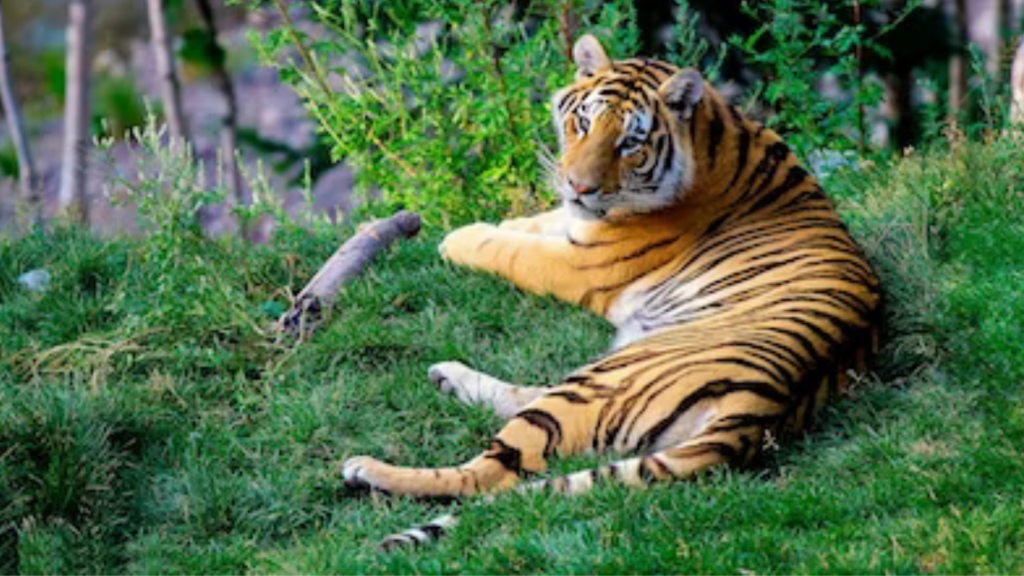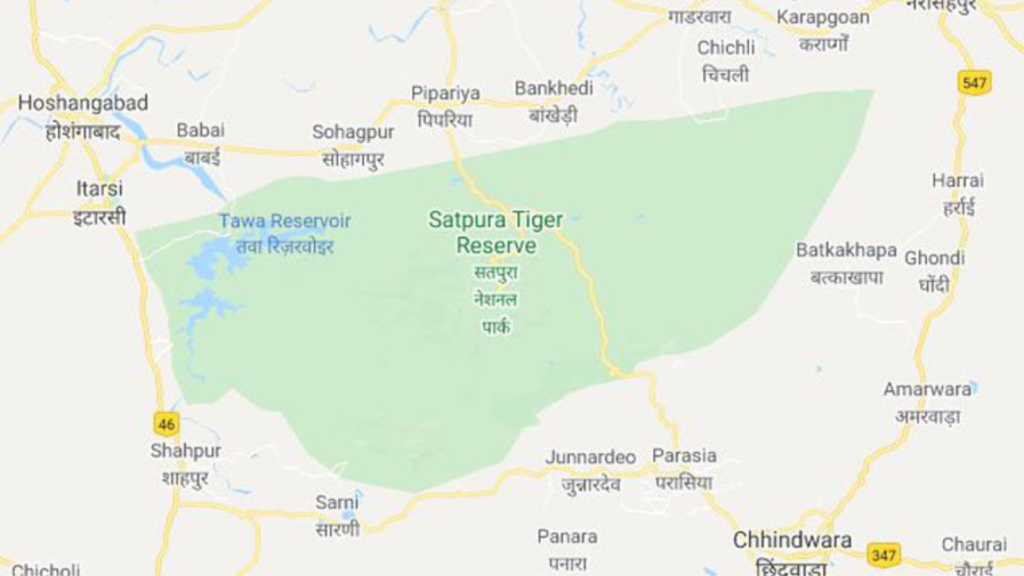
The Satpura Tiger Reserve (STR), also known as Satpura National Park, is situated in Madhya Pradesh’s Narmadapuram District. The Satpura range inspired the name of the region. It has a 524 km2 (202 sq mi) surface area. Together with the neighboring Bori and Pachmarhi wildlife sanctuaries, Satpura National Park offers 2,200 km2 (850 sq mi) of a rare central Indian highland habitat. It was established in 1981.
The national park’s landscape is made up of sandstone peaks, deep ravines, little gorges, and exceptionally rough terrain. The elevation varies from 984 to 4,436 feet or 300 to 1,352 meters. It features the nearly flat plains of Churna and the 1,350 meter-high Dhoopgarh hill (4,430 ft).
The national park’s closest town is Pachmarhi, while the closest rail station is Pipariya, which is located 55 kilometers (34 miles) away. Bhopal, the state capital, is 130 miles or 210 kilometers distant.
The fauna of Satpura National Park is abundant. Leopard, sambar, chital, Indian muntjac, nilgai, four-horned antelope, Chinkara, wild boar, bear, black buck, fox, porcupine, flying squirrel, mouse deer, and Indian giant squirrel are among the inhabitants of this area. There are several kinds of birds. Peafowl and hornbills are frequent bird species here. Sal, teak, tendu, Phyllanthus emblica, mahua, bel, bamboo, as well as grasses and medicinal plants, make up the majority of the flora.
Tiger, dhole, Indian gaur, and barasingha sightings have been reported in prior years, however these are uncommon.

History:
The Satpura Range serves as the source of its name. The Sanskrit term “saptpura” (sapta means “seven” and pura means “mountain”) signifies “seven mountains.” While looking for Indian Freedom Fighter Tantya Tope in 1862, Bengal Lancers Captain James Forsyth first discovered it. Due to its ecological and commercial significance, it was one of the first Reserved Forest Areas in India to be officially designated. Since it became a tiger reserve in 2000, it is now known as Satpura Tiger Reserve (STR).
With the addition of Pachmarhi & Bori Sanctuaries and Satpura Tiger Reserve, Satpura National Park spans 1427 km2 in the Madhya Pradesh districts of Narmadapuram and Chhindwara.
Flora:
Due to its location in a diverse Central Indian forest ecology, the Satpura Tiger Reserve has a high biodiversity. Over 1300 plant species, including teak, Sal, tendu, mahua (Indian butter-tree), bel (stone-apple), bamboos, and grasses, may be found in Satpura Tiger Reserve. More than 62 tree species, 30 small tree species, 58 shrub species, 32 climber species, and about 64 grass species can be found at Satpura Tiger Reserve. Additionally, it has uncommon endemic species from the genera Psilotum, Cyathea, Osmunda, Lycopodium, and Lygodium as well as significant medicinal herbs. The National Park’s most notable plant, saal, is mostly found on the Pachmarhi plateau. Teak forests atop basaltic traps dominate the lower plains on the park’s northern edge.There are several species that can only be found in the Satpura Tiger Reserve in Madhya Pradesh, including Melastoma malabathricum, Murraya paniculata, Holmskioldia senguinea, Blumea lanceolaria, and Sophora interrupta.
Grassland:
10% of the Satpura Tiger Reserve is designated as grassland, including the naturally occurring emptiness on the Pachmarhi plateau, anthropogenically created grassland from the evacuation of settlements, and the Tawa reservoir’s drawdown regions. Neemghan, Madai, Keria, Dhain, and Geetkheda are the names of these grasslands. The removal of 23 settlements from the reserve’s central region has also resulted in the creation of some additional meadows. Most of the existing grasslands are anthropogenically created and used for grazing and cultivation. These grasslands will soon vanish if nothing is done to prevent the invasion of woody plants. The Satpura Tiger Reserve management provides these grasslands with a high level of protection and upkeep in order to maintain a sizable population of animals that rely on them.
Fauna:
There is a sizable and diverse population of animals in Satpura National Park and the area surrounding it, which is uncommon in other national parks. The list of animal species that are now present demonstrates the unique environment and lengthy history of wildlife conservation in this woodland region. For lovers of animals, Satpura National Park’s biodiversity is a breathtaking jungle feast. The park is home to 30 species of reptiles, 50 species of butterflies, 254 species of birds, and 50 species of mammals. There are several species of beautiful birds, such as the Malabar whistling Thrush, Paradise Fly-catcher, Honey Buzzard, and Malabar pied Hornbill.Oakleaf, Black Rajah, Great Eggfly, Blue Pancy, and other butterfly species may thrive in the presence of a broad diversity of flower species in damp circumstances.
Its fauna includes, in addition to birds and butterflies, Spotted Deer, Indian Bison (Gaur), Tigers, Leopards, Wild boar, Wild dog (locally known as Dholes), Sloth bear, Black buck (a unique attraction), Porcupine, Sambhar, Barasingha, four Horned antelopes (Chowsingha), Pangolin, Marsh crocodile, Languars, etc. The Satpura Tiger Reserve is home to roughly 14 species of critically endangered animals and reptiles. Given that they are currently uncommon in India, Indian Giant Squirrels are one of Satpura Tiger Reserve’s unique features. Some species, including Rhesus monkeys, flying squirrels, and Indian giant squirrels, are unique to Central India.
Climate:
In Central India, where temperate weather is the norm, is where Satpura National Park is located. The summer season lasts from March through June, when the temperature can reach 30 °C in the morning and 40 °C during the day. Although May and June are the hottest months of the year with heat waves, the temperature stays mild in higher elevations. The monsoon season begins in July and lasts through September or October. There are between 1300-1700 mm of rain per year on average in the area. The park’s primary water supply is the Denwa River, on which the Tawa Dam was constructed. The national park’s climatic conditions are influenced by its extensive catchment area.From November through February, there is a winter season, when the temperature surrounding the Pachmarhi Plateau drops to 4 °C in the morning and rises to 15 °C during the day. Pachmarhi has the lowest recorded temperature, which is just 1 degrees. Generally speaking, the winters are sunny and clear, with a few small rains in early November.



